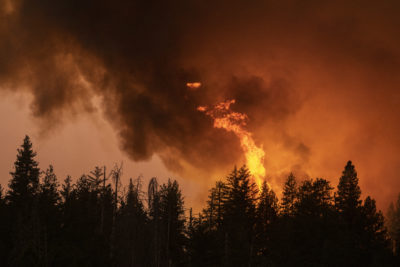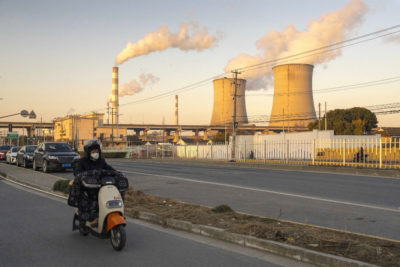Attributable to lax pointers, nationwide inventories reported to the United Nations grossly underestimate many worldwide places’ greenhouse gasoline emissions. The tip outcome, analysts say, is that the world can not verify compliance with agreed emissions targets, jeopardizing world native climate agreements.
They’re imagined to be the climate-savers’ gold customary — the vital factor information on which the world relies upon in its efforts to lower greenhouse gasoline emissions and preserve world warming in study. Nevertheless the nationwide inventories of emissions supplied to the United Nations native climate convention (UNFCCC) by most worldwide places are one thing nonetheless reliable, in response to a rising physique of research.
The knowledge supplied to the UNFCCC, and printed on its website online, are typically outdated, inconsistent, and incomplete. For a lot of worldwide places, “I won’t put loads price, if any, on the submissions,” says Glen Peters of the Centre for Worldwide Native climate Evaluation in Norway, a longtime analyst of emissions tendencies.
The knowledge from large emitters is as loads open to questions as that from smaller and fewer industrialised nations. In China, the uncertainties spherical its carbon dioxide emissions from burning coal are larger than the complete emissions of many major industrial worldwide places. And corporations preparing information for its carbon-trading system have been accused of widespread information fraud.
Within the US, an analysis printed this month of the air over the nation’s oil and pure gasoline fields found that they emit thrice additional methane — a gasoline answerable for a third of current warming — than the federal authorities has reported.
“The current patchwork of greenhouse gasoline inventories is woefully inadequate… [and] rife with measurement errors,” an analyst says.
Within the meantime, a Yale Environment 360 evaluation of U.N. information has found that Qatar, the pure gas-rich Gulf state with the world’s highest per-capita CO2 emissions, has all nonetheless given up publicly reporting its emissions. Its closing formal submission to the UNFCCC solely lined emissions as a lot as 2007. Since then, the nation’s undeclared emissions have practically doubled.
The proof of these greenhouse-gas bookkeeping failings lies within the precise atmosphere. By one present rely, nationwide emissions inventories entire merely 70 p.c of the actual additions to the air, as calculated using distant sensing and model analysis. The remaining 30 p.c are unaccounted for.
Due to this, say analysts, the world is flying blind, unable each to substantiate nationwide compliance with emissions targets or decide how loads atmospheric “room” worldwide places have left for emissions sooner than exceeding agreed warming thresholds.
The UNFCCC requires worldwide places to report often and intimately on their greenhouse gasoline emissions. “Transferring confidently in route of net-zero emissions requires high-quality emissions statistics for monitoring worldwide places’ progress,” says Jan Minx, a climate-change protection analyst at Berlin’s Mercator Evaluation Institute on World Commons and Native climate Change. Nevertheless for lots of worldwide places, along with just a few of the most important emitters, analysts say, no such reliable statistics exist.

A smoggy day in New Delhi in January 2021.
Jewel Samad / AFP by means of Getty Pictures
One motive is that the reporting pointers for nationwide inventories are a political compromise. They’re actual and detailed for rich developed nations, recognized in U.N. native climate jargon as Annex 1 nations. Even when there are gaps, “these are the gold customary, well-resourced and peer-reviewed,” says Peters.
Nevertheless the rules are loads a lot much less rigorous for creating worldwide places, known as non-Annex 1 nations, which earlier to the 2015 Paris Settlement did not have emissions targets. Data submissions from them will probably be arbitrary, usually outright implausible, and are infrequently independently checked, analysts observe.
This regardless that many “creating” nations, along with China, have emissions increased than their “developed” counterparts. Due to this, two of in the meanwhile’s three largest emitters — China and India — along with oil-rich Gulf states with per-capita emissions elevated than any Annex 1 nation, need solely regulate to the a lot much less strict reporting necessities.
“I won’t perception a non-Annex 1 emissions estimate with out cross-checking all through a lot of sources,” says Peters.
“The current patchwork of greenhouse-gas inventories is woefully inadequate,” concluded Amy Luers, director of sustainability science at Microsoft, in a 2022 evaluation with tutorial colleagues for Nature. They’re “rife with measurement errors, inconsistent classification and gaps in accountability.” The state of affairs is made worse, says coauthor Leehi Yona, an environmental lawyer at Stanford Faculty, by “inflexible and outdated” U.N. pointers for nationwide reporting.
Qatar, considered the world’s highest per capita emitter, has solely filed a correct inventory of its emissions as quickly as, with information for 2007.
The reasons for the data gaps fluctuate. Some emissions are eminently measurable nonetheless are expressly excluded from the U.N. reporting system on account of there is not a settlement on how one can apportion them to nationwide inventories. These embrace worldwide aircraft and supply, which make up spherical 5 p.c of world emissions.
One different class is military train. It is “a few of the urgent,” says Matthias Jonas, an environmental scientist on the Worldwide Institute for Utilized Methods Analysis in Austria. He has found that military gasoline use, ammunition firing, and fires set off by bombing in the middle of the primary 18 months of the battle in Ukraine caused additional emissions than Portugal. One different analysis estimated that the U.S. military moreover emits additional CO2 than Portugal’s nationwide entire.
The British advocacy group Widespread Wealth closing 12 months calculated that globally armed forces may be answerable for better than 5 p.c of world CO2 emissions. Nevertheless “we don’t want pointers for estimating these emissions and attributing obligation,” says Jonas. So, they principally keep off the books.
One different gaping information hole is forest fires, says Yona. Globally, wildfires emit spherical 1.5 billion metric tons of CO2 yearly, better than all nonetheless the world’s excessive 5 CO2 emitters. Wildfires may be a pure hazard, nonetheless in a number of worldwide places, they’re principally ignited by individuals and are typically made worse by poor fire administration and gasoline left in damage’s method. That makes them anthropogenic, she argues. So, the following CO2 emissions must operate in nationwide inventories of human-caused emissions. Nevertheless principally they don’t.

The Oak Fireplace burns near Mariposa, California, in July 2022.
David McNew / AFP by means of Getty Pictures
Thus, California’s wildfire emissions have in some years been as good as these from the state’s power stations. Nevertheless the state authorities excludes them from its greenhouse-gas inventories, “regardless that they are large, measurable, reducible and overwhelmingly attributable to human train,” Yona says.
The problem of underreporting is compounded on account of, in response to most of the people on-line report, many non-Annex 1 nations have been terribly sluggish in meeting their requirement to submit inventories every 4 years. Some backsliders are states at warfare or with unstable governments. Syria closing filed in 2010, Myanmar in 2012, Haiti in 2013, and Libya has in no way filed. Nevertheless others have no such excuse. The Philippines closing despatched its inventory in 2014, and Guyana in 2012.
Most startling is Qatar — a severe Gulf natural-gas exporter with per-capita emissions broadly considered the perfect on the earth. At better than 35 tons of CO2 per particular person, Qataris emit better than twice as loads as People. Nevertheless their authorities has solely filed a correct inventory of those emissions as quickly as, in 2011, and provided information for 2007. Since then, Qatar’s exact emissions are thought to have practically doubled.
Satellite tv for pc television for computer information reveals methane emissions from oil and gasoline fields globally are spherical 70 p.c elevated than governments declare.
The UNFCCC internet internet web page on reporting pointers says: “With out transparency, we’re left to behave blindly.” Nevertheless a spokesperson talked about in an e mail that the UNFCC had no potential to compel worldwide places to submit effectively timed inventories, which are a “non-mandatory requirement.” Moreover, the spokesperson well-known, “most non-Aannex 1 occasions face functionality constraints… along with these for reporting.” Peters retorted that “Qatar could more than likely pay a crew of fifty of us to do primarily essentially the most appropriate estimates of emissions ever, nonetheless it is not of their pursuits.”
Even when nationwide returns are up to date and full, uncertainties abound, says Efisio Solazzo, who analysis air air pollution statistics for the European Price’s Joint Evaluation Centre in Italy. There are shortcomings in “train information.” We don’t know, as an illustration, how loads fossil gasoline is being burned in a number of worldwide places, nor how loads methane leaks from oil and gasoline fields and pipelines.
There are moreover uncertainties in how reliably these actions are reworked into emissions estimates. That’s often executed using off-the-shelf formulae developed by scientists for the U.N. Nevertheless critics say these formulae usually fail to reflect precise working circumstances.
When John Liggio, an air top quality researcher at Environment and Native climate Change Canada, a authorities firm, cross-checked his authorities’s declared emissions from the energy-intensive extraction of the oil sands deposits in Alberta, the outcomes have been embarrassing. Aircraft measurements of CO2 throughout the air above the tar sands suggested that the precise emissions have been 64 p.c elevated than these being reported.
Typically full industries are beneath a cloud. Satellite tv for pc television for computer information analysed by the Worldwide Vitality Firm (IEA) reveals methane emissions from oil and gasoline fields globally are spherical 70 p.c elevated than governments declare, primarily on account of unreported leaks and flaring.
The U.S. enterprise is a severe wrongdoer proper right here. Using measurements from tons of of research flights over correctly fields, Evan Sherwin, a information analyst on the authorities’s Lawrence Berkeley Nationwide Laboratory, found that 3 p.c of the methane tapped by American oil and gasoline wells leaks into the atmosphere, compared with the one-percent estimate utilized in U.S. inventories.
Globally, there are tons of of what the IEA calls “super-emitter events” yearly, principally from oil and gasoline fields. Outside the U.S., a number of the worst are in Turkmenistan and completely different former Soviet states of Central Asia, which recurrently nonetheless use decaying and leaky Russian-built infrastructure. One big blowout in Kazakhstan closing 12 months took 200 days to plug.
Governments globally declare forests are absorbing 6 billion tons additional CO2 yearly than scientists can account for, a analysis found.
Typically the data gaps are additional delicate. For example, standardized emissions parts for burning coal disguise the reality that a number of kinds of coal from utterly completely different places have utterly completely different emissions costs. Some analysis have suggested that the poor-quality coal from many mines in China produce significantly a lot much less CO2 than the emissions parts advocate. Nevertheless completely different analysis advocate the nation usually burns additional coal than it admits to. So, a cloud nonetheless hangs over the nation’s emissions inventories.
“China is making good efforts to boost the accuracy of its emissions inventories,” says Yuli Shan of Birmingham Faculty throughout the U.Okay., who has tracked its information for years. Nevertheless he notes that an analysis of China’s fossil-fuel emissions by the European Price’s Emissions Database for World Atmospheric Evaluation found 23 p.c better than recorded throughout the nation’s U.N. submission for the same 12 months.
Points about China have elevated with the introduction of the nation’s carbon shopping for and promoting system, which analysts say could allow vitality corporations to income by fiddling the figures. Two years up to now, China’s setting ministry found 4 corporations auditing offset claims had routinely tampered with coal samples, doctored check out outcomes, hid vitality output information, and provided fictitious verification research for his or her power-station purchasers, so lowering the declared emissions.

The Wujing coal-fired power plant in Shanghai.
Raul Ariano / Bloomberg by means of Getty Pictures
Away from the vitality enterprise, information discrepancies are typically even increased. Emissions from some chemical processes and landfills are poorly assessed, says Solazzo. So are methane emissions from cattle and rice manufacturing, whereas estimates of the worldwide releases of nitrous oxide from fertilized soils could very effectively be undercounted by a component of three.
There may also be beforehand unconsidered anthropogenic emissions. This month, ecologist Trisha Atwood of Utah State Faculty printed calculations suggesting that fishing trawlers that churn up the ocean floor are releasing additional CO2 into the atmosphere yearly than Good Britain.
Then there are forests. Geographer Clemens Schwingshackl on the Ludwig-Maximilians Faculty in Munich found that governments collectively declare their forests are absorbing 6 billion tons additional CO2 yearly than scientists can account for. That gap is bigger than entire U.S. emissions from all actions.
The good news is that such ruses in nationwide inventories are beneath ever increased scrutiny from improved aircraft- and satellite-based information assortment. The accuracy of this work is being improved by increased modeling of the tracks of air air pollution by way of the air and by testing air samples for carbon 14. This isotope, with a half-life of 5,700 years, is ever present in pure emissions of CO2 nonetheless absent from the burning of fossil fuels which have been buried for tens of tens of millions of years. NOAA researchers have currently used this to hint U.S. fossil-fuel emissions additional precisely and say they might try this for various nations too.
Nevertheless the harmful info is that this new information infrequently reaches nationwide inventories, which keep caught in outdated, usually self-serving, strategies. Whereas that continues, the data gaps between reported emissions and the exact gases accumulating throughout the atmosphere will persist. And the world will keep unclear about who’s accountable and what’s required to meet native climate targets.
